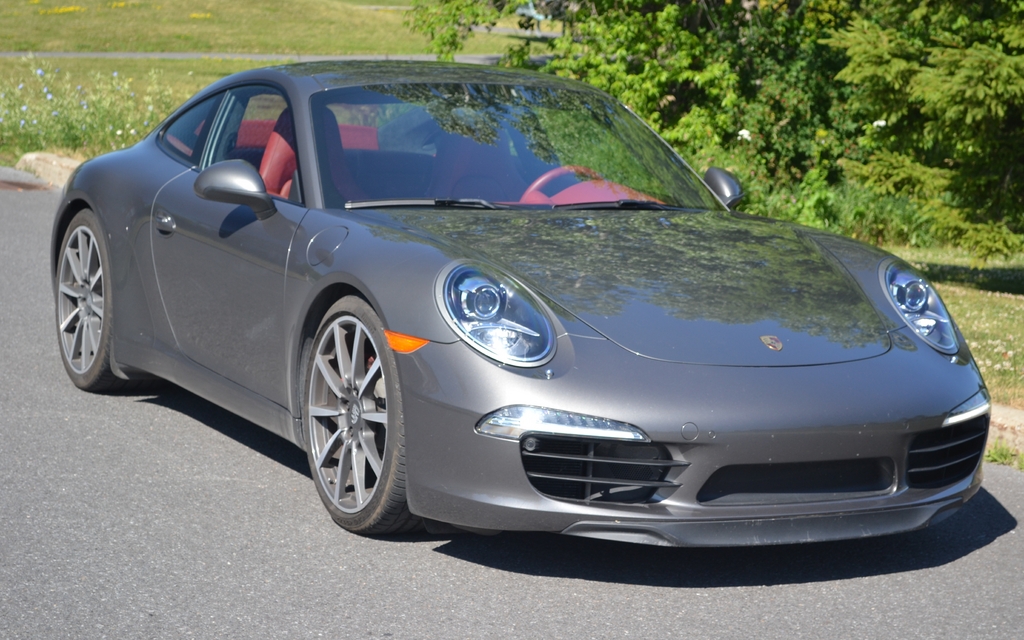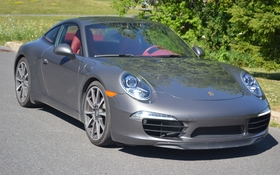Porsche 911 Carrera S: An engineering masterstroke

| Strong points |
|
|---|---|
| Weak points |
|
It’s hard to resist the Porsche 911’s charms. Introduced 50 years ago, it has become a true automobile icon. Of course, with such a rich heritage, introducing new generations isn’t easy for Porsche. Keeping the model competitive means preserving the existing features while adding just enough new ones, knowing full well that any changes will be closely scrutinized. The vehicle’s clientele can be inflexible if Porsche dares to stray too far from the model’s beginnings.
This year marks the arrival of the seventh generation 911, and the Carrera and Carrera S (coupe and cabriolet) are the first to come out. All the AWD platforms, including the Turbo versions, are under the old generation’s 997 name. As is always the case, just when you think that the performances simply cannot be improved, Porsche manages to surprise us with another stroke of genius. The Stuttgart-based manufacturer is shouting from the rooftops that this new 911, codename 991, is the most complete Porsche ever produced.
Pumping up the volume
At Porsche, every makeover is more of an evolution than revolution. Your everyday person would have to look very closely to spot the exterior changes. Although the roofline remains curved and the headlights are still round, this time the car has kept only 5% of the previous generation’s features. The new 911 is longer, wider and lower. In front, larger fenders reinforce the car’s stockier style and the air intakes are more imposing. On the sides, the mirrors have been moved to the uppermost corner of the door, reminiscent of the Carrera GT. It’s hard not to be taken with the optional 20-inch wheels. In back, the spoiler is slightly larger but the most significant change is the narrower lights whose shape is Aston Martin-esque.
Inside, anyone who has spent time aboard the Panamera will notice several similarities, especially with the central console that looks like fighter plane instrumentation (as is the case on the Panamera and Cayenne). Not only is it visually stunning, but it’s much more ergonomically sound. Appropriately for a sports car, there’s a large rev counter in the centre of the instrument panel and a much smaller speedometer located just to the left. Fortunately, there’s a second, more readable and more practical digital speedometer at the bottom of the rev counter. The gauge on the right contains a digital screen that displays different information depending on your needs, including instructions for the navigation system.
It goes without saying that the 911 isn’t the most suitable vehicle for family activities. Cargo space is limited to the deep but not terribly large front trunk. However, the 911 has an advantage over the Boxster and the Cayman: it has two seats in back that, while very small, can still accommodate two children or extra baggage.
More power, less gas
Under the hood, or rather, on the rear axle, the 2012 Carrera has a 3.4-litre six-cylinder engine replacing the 3.6-litre. Despite the smaller engine capacity, this engine develops 350 horses, five more than the old six-cylinder. Paired with the world’s first seven-speed manual gearbox, the base version of the Carrera goes from 0-100 km/hr in about 4.6 seconds, and 4.2 when equipped with the optional PDK sequential gearbox and the Sport Chrono Package. Performance remains more than reasonable, but Porsche’s greatest accomplishment was with the trendiest topic of the day: fuel economy. Don’t be surprised if you don’t hear your engine purring at a stop light, Porsche has paired the PDK gearbox with a Start/Stop system that automatically cuts the engine at stops, in the name of fuel economy.
Not to be outdone, the Carrera S’ 3.8-litre six-cylinder has been upgraded this year and is, of course, more powerful as well. It develops 400 horses compared to the previous version’s 385 and is more fuel efficient. This engine can be paired to the same transmission choices as the base version and it can go from 0-100 km/hr in four seconds.
On the road
You only truly realize how advanced this car’s engineering is when you take the wheel. You’ll immediately fall under the spell of the 911 Carrera S’ increased power and its engine, which emits an unusual, far-reaching sound during accelerations. Its 400 horses literally glue you to the seat, much to the delight of both driver and passenger. Getting onto a road or highway is suddenly a breeze. Tack on a glut of electronic systems designed to maximize performance and you get a beast capable of race track-worthy performances.
The wider wheelbase favours increased stability at high speeds, even though this wasn’t really a problem before. As a result, though, the hardest thing to do aboard the 911 is contain your enthusiasm so as not to earn any demerit points on your license. This car is designed for the autobahn, and certainly not your average Canadian highway!
The 2012 911 Carerra is easy to drive, thanks in large part to the sport steering wheel that improves control. Visibility is excellent, the seats are adequately supportive and the large footrest helps anchor you to the seat. The vehicle’s engineers carefully considered each of these elements in the interest of maximizing the driving experience. This year, the 911 Carrera is equipped with lighter electromechanical steering that responds differently depending on speed, facilitating low speed manoeuvres. We’re rarely impressed by this type of steering in a sports car, but in the case of the 911, it seemed very smooth.
Sure, as far as sports cars go, there are more extroverted and more exclusive models out there – you see all kinds of 911s on Canadian roads – but you have to admit that few manufacturers can boast offering models as reliable or claim to be supported by such a wide network of dealerships. The 911 is not only capable of great performances, but it can also be pleasant to drive in everyday conditions.











